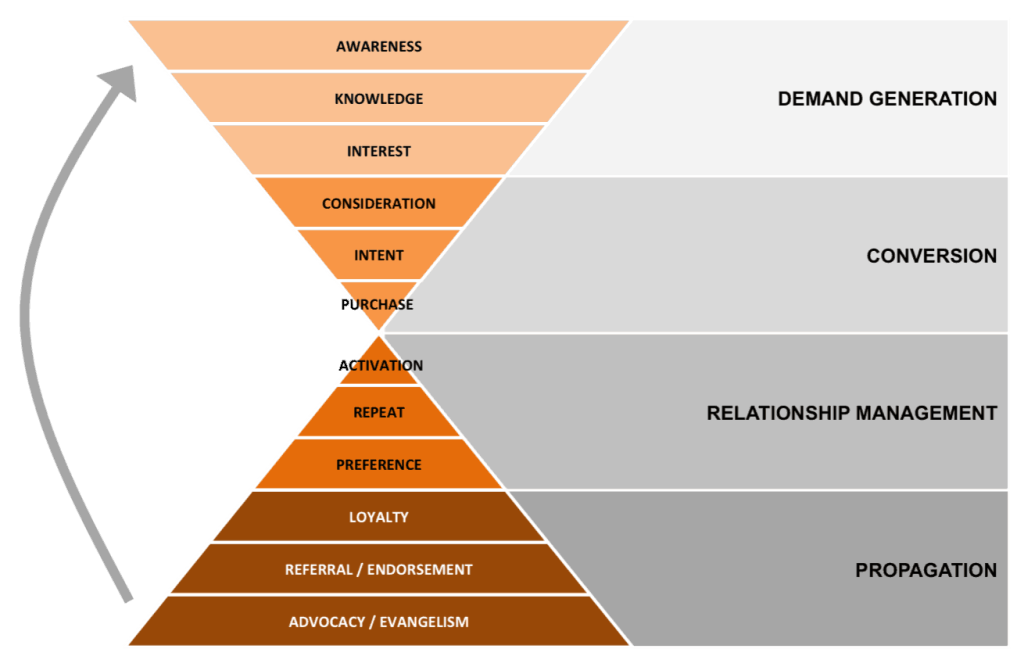Fresh off the heels of this year’s Content Marketing World, I left with the sense that many people believe that content marketing is simply an exercise in creating helpful quality content that doesn’t sell anything. That simply isn’t the case. Content marketing should fill the information needs at every stage of the marketing, sales and customer service funnel.
If not, brands can have a leaky hourglass. If demand generation (top-funnel) content produces 20% marketing qualified leads (MQLs) from its raw leads, but only converts 4% of its MQLs to sales qualified leads (SQLs) than there’s a leak. My good friend Michael Brenner has shown benchmark data from his time at SAP of thousands of leads. It suggested the 10/10/10 rule for the various stages of the first funnel.

In other words, expect 10% of raw leads to turn into MQLs, 10% of those to turn into SQLs, and 10% of those to turn into sales. Anything below 10% and there’s a problem. If there is no content (or inadequate content) for any of those conversion phases of the buyer’s journey, it can lead to below-benchmark numbers. That means that we’re not doing our job as content marketers.
Content marketers like to believe that their audience is their customer. That’s not the case. Sales is marketers’ customer. If not, it would be like a farmer calling the corn in his field his customer. It’s the marketer’s job to harvest the audience for sales. Just like a farmer uses fertilizer, content marketers use content to build their audience, move it through the buyer’s journey, and help sales close the deal.
This is also reflected by companies that have enacted account based marketing (ABM). To do ABM many companies enact a service level agreement (SLA) between Sales and Marketing. This is, essentially, a contract that defines the definition of a lead and the role of both departments. The SLA puts in writing that Sales is the customer of Marketing.
This is clearly a B2B example, but Google’s 2011 Zero Moment of Truth shows that consumers go through a similar journey (albeit much faster in many cases) when interacting with a B2C brand. This isn’t to say that top-funnel content isn’t important. It absolutely is. However, it shouldn’t represent 100% of a content marketer’s effort.
Depending on the brand, top-, mid- and bottom-funnel (conversion) content should be prioritized at 70/20/10 or something similar. In other words, focus 70% of effort on top-funnel content, 20% mid-funnel content, and 10% on bottom-funnel content.
Unfortunately, mid- to bottom-funnel content often gets forgotten at conferences, webinars and blogs. Doing a session on how to write a winning case study or how to design the best online catalog isn’t the sexiest thing to do, but depending on the brand, it’s just as critical as how to write a winning blog post.
Since 30% of a content marketers’ efforts should be spent on conversion content, speakers, presenters and blog writers should be addressing this very important need in content marketing. Distribution for this type of content has been around for a long time – PPC, display. There’s lots of resources and conferences about how to use those distribution channels, but very little on what content should be distributed.
This is why many content marketers still believe their job is to create top-funnel content exclusively and that their customer is their audience. This thinking is pervasive and can lead to a leaky funnel. It’s going to take some time, but I’m confident this way of thinking will dissipate. It has to or brands will start abandoning content marketing because they don’t believe it works.